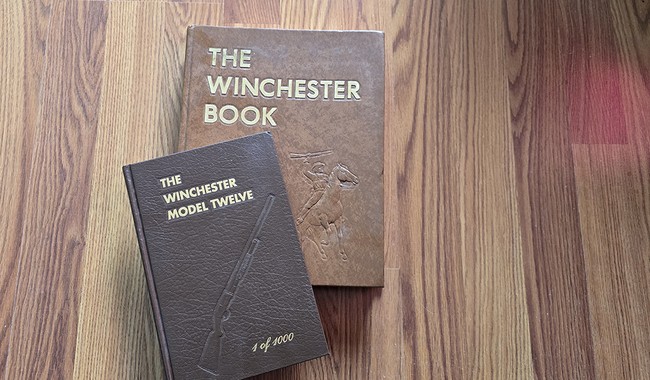Winchester Historian George Madis
George Madis was a remarkable man.
Most folks who are collectors of, well, anything, will have not only the items they collect but also tomes of information on whatever it is they collect. My thing (as you know if you’re reading this) is guns, and I have quite a shelf of gun references, including such items as the definitive piece on Mauser, Ludwig Olson’s “Mauser Bolt Rifles.”
As everyone who has been reading these Sunday Gun Day columns knows, I’m a fan and collector of Belgian Brownings and pre-64 Winchesters, and I have not only the guns but books about them to support my collecting. For my collection of Winchesters, I have two key books among my desk reference tomes, both by George Madis and, in fact, both signed by the author himself. Those books are “The Winchester Book” and “The Winchester Model 12.” If you’re interested in old Winchesters, these are the gold standard. Why? Well, here’s why, and I’m going to tell you.
The Man
Oddly, very little information is available online about George Madis the man. He was a Winchester collector, something of a Winchester corporate historian, and the author of several definitive books about Winchester rifles and shotguns. He passed away in 2003 at the age of 72 and was well-regarded by all who knew him. That, and the fact that he was a Winchester aficionado, is all I have been able to find out about him. In the depth and breadth of the internet, I’ve not been able to uncover any personal details about the man. (If anyone reading this knows anything about Mr. Madis the man, please feel free to let me know in the comments.)
 But I’m pretty familiar with George Madis’ work.
But I’m pretty familiar with George Madis’ work.
The Books
When I first started getting hooked on old Winchesters, my oldest bestest friend Dave showed me his copy of “The Winchester Book.” This book was originally published in 1961; mine is from a 1979 printing run of 1,000 books (or so I’m told), each copy of which was personally signed by Mr. Madis. Mine does indeed carry this signature. This benchmark work encompasses the history of Winchester arms from the very beginning, including these sections:
- The Forerunners
- The Lever Action Models
- The Bolt Action Models
- The Slide Action Models
- For All Models (including sights, special order features, and so on.)
The first section includes some real obscure pieces, all of which contributed to Winchester’s early, ground-breaking lever guns. The Hunt and Jennings repeaters are described, along with the early Volcanic models that set the basic layout for lever-action rifles that remain in place today. This history continues in the second section, beginning with the Model 1866 through the Model 1895.
See Related: Sunday Gun Day XLIV - Five Great American Guns
In fact, most of “The Winchester Book” is taken up with the description of the company’s many and varied lever-action rifles. The company’s bolt guns are described in Part 3, including the famous Model 54 and, of course, the Model 70, the “Rifleman’s Rifle.” Slide-action rifles shotguns include the little Model 1890 .22 rimfire as well as the Model 93/97, Model 12 shotguns – and semi-autos, including the Winchester Self-Loading carbines. My daughter’s father-in-law has one of the M1905 carbines in the.351 Winchester Self-Loading and it’s a fun, agile little thing, packing more or less the punch of a .357 Magnum in a light, handy carbine.
It's interesting that this fantastic book devotes so much time to the history of lever guns, and seemingly little space to guns as famous as the Model 70 and the Model 12. But then, the Model 12 has its own book, and since I’m a fan of the Model 12, one of those references resides on my desk reference shelf as well. And Winchester was, if anything, a lever gun company. It’s not surprising that Madis’ work reflects that. Winchester even made a lever-action shotgun, the Browning-designed Model 1887/1901. The story has it that Winchester approached the Maestro about designing them a shotgun; Browning responded by pitching a slide-action gun, but Winchester said they were a lever-gun company and by gosh they wanted a lever-action shotgun. The result was the big, clunky Model 1887, later refined slightly into the Model 1901. That gun didn’t blow up many skirts, prompting John Browning to say, “I told you so” and gifting Winchester with the history-making Model 1897 pump gun.
See Related: Sunday Gun Day XLIII - Five Great American Gun Designers
When I first started looking at collecting examples of The Perfect Repeater, I found a copy of Madis’ 1982 work “The Winchester Model 12,” which is essential reading for anyone interested in this famous shotgun, which remains the standard against which all slide-action shotguns are judged; one wonders what might go through the mind of a young, modern-day designer working up a new design for a pump-gun and wondering, “How is this going to measure up against the Model 12?”
I doubt there is or ever has been a variation of the Model 12 that isn’t described in this slim book, with the possible exception of some special-order one-offs. My aforementioned buddy Dave, who is also a Winchester collector, has one such, a factory-custom trap gun in 16 gauge. But other than those few, if Winchester made it, it’s in this book. There’s a lot of history, too, starting with the John Browning-designed Model 1897, and how Winchester engineer T.C. Johnson, in altering the M1897 to produce the Model 12, achieved the impossible: Improving one of the Maestro’s designs.
Madis wrote other books on the topic:
- The Winchester Handbook (1981)
- The Winchester Era (1984)
- Winchester: Dates of Manufacture 1840-2000 (1984)
I haven’t had the chance to peruse these books, so I can’t tell you too much about them.
Madis’ writing style is a little textbookish and academic. But both books mentioned here are well-organized, well-indexed, and lavishly illustrated. If you’re looking to identify an old Winchester, Madis makes it easy to run down precisely what it is you’ve got and when it was made.
The Legacy
For Winchester collectors, George Madis’ works are the go-to books. Sadly they are out of print now. Both of mine, “The Winchester Book” and “The Winchester Model 12” were published in limited numbers; as the saying goes, what there is, is “all there is and there ain’t gonna be no more.”
There are still copies available on the various online used bookstores and auction sites. If you think you might want to find one, don’t put it off too long.














